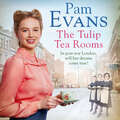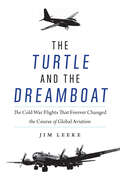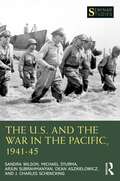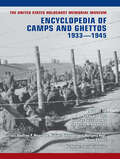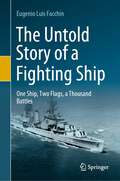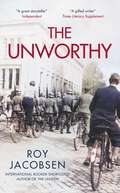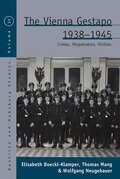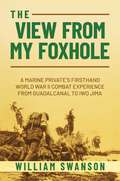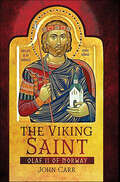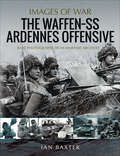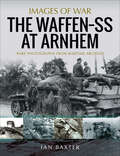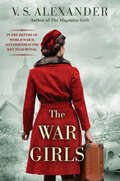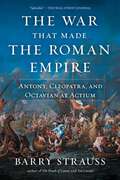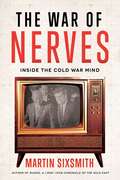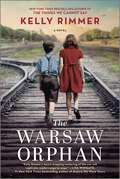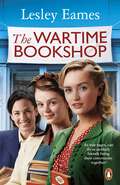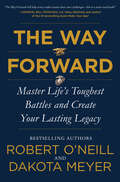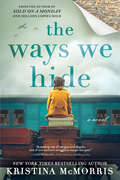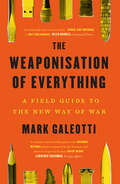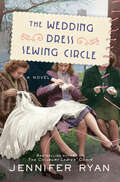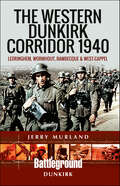- Table View
- List View
The Tulip Tearooms: A compelling saga of heartache and happiness in post-war London
by Pamela EvansTHE TULIPTEA ROOMS is a heartwarming and poignant saga from Pam Evans, set in London just after the Second World War. Perfect for readers of Kitty Neale, Katie Flynn and Dilly Court.The Second World War is finally over when Lola Brown meets Harry Riggs at a dance. It is love at first sight but when Harry tells Lola that he is a policeman, her heart sinks. Lola's father is a petty criminal, and if Harry ever finds out and turns him in, it will destroy her family...Harry reluctantly accepts that Lola doesn't want to see him again, and eventually starts to find happiness without her. In the meantime, Lola encounters the eccentric Pickford sisters and sets about transforming their run-down tearooms in London's West End, only to find her own life transformed as well. Despite everything, Harry and Lola continue to feel drawn to each other, but the truth about Lola's family can't stay hidden for ever...(P) 2022 Headline Publishing Group Ltd
The Turtle and the Dreamboat: The Cold War Flights That Forever Changed the Course of Global Aviation
by Jim LeekeThe &‘Turtle&’ and the &‘Dreamboat&’ is the first detailed account of the race for long-distance flight records between the U.S. Army and U.S. Navy less than fourteen months after World War II. The flights were risky and unprecedented. Each service intended to demonstrate its offensive capabilities during the dawning nuclear age, a time when America was realigning its military structure and preparing to create a new armed service—the United States Air Force. The first week of October 1946 saw the conclusion of both record-breaking, nonstop flights by the military fliers. The first aircraft, a two-engine U.S. Navy P2V Neptune patrol plane nicknamed the Truculent Turtle, flew more than eleven thousand miles from Perth, Western Australia, to Columbus, Ohio. The Turtle carried four war-honed pilots and a young kangaroo as a passenger. The second plane, a four-engine U.S. Army B-29 Superfortress bomber dubbed the Pacusan Dreamboat, flew nearly ten thousand miles from Honolulu to Cairo via the Arctic. Although presented as a friendly rivalry, the two flights were anything but collegial. These military missions were meant to capture public opinion and establish aviation leadership within the coming Department of Defense. Both audacious flights above oceans, deserts, mountains, and icecaps helped to shape the future of worldwide commercial aviation, greatly reducing the length and costs of international routes. Jim Leeke provides an account of the remarkable and record-breaking flights that forever changed aviation.
The Twin Secret She Must Reveal (Scandals of the Le Roux Wedding #3)
by Joss WoodTheir attraction returns instantly! But she still has two big secrets to reveal in this secret baby romance from Joss Wood.She has a confession: Her sons are also his! Thadie Le Roux has not one but two reminders of those incredible hours in Angus Docherty&’s arms. But unable to contact her twins&’ elusive father, the society heiress decides she has to move on. Until she&’s caught in a paparazzi frenzy and the security expert who rescues her is Angus himself! Learning he&’s a father changes everything for lone-wolf Angus—except the dizzying desire he feels for Thadie. So when she escapes to a private Seychelles island, Angus will accompany her. And he will discover what this means for their future…From Harlequin Presents: Escape to exotic locations where passion knows no bounds.Read all the Scandals of the Le Roux Wedding books: Book 1: The Billionaire's One-Night BabyBook 2: The Powerful Boss She CravesBook 3: The Twin Secret She Must Reveal
The U.S. and the War in the Pacific, 1941–45 (Seminar Studies)
by J. Charles Schencking Michael Sturma Sandra Wilson Dean Aszkielowicz Arjun SubrahmanyanThe U.S. and the War in the Pacific, 1941-45 analyzes the Pacific War with a focus on America’s participation in the conflict. Fought over a great ocean and vast battlefields using the most sophisticated weapons available, the Pacific War transformed the modern world. Not only did it introduce the atomic bomb to the world, it also reshaped relations among nations and the ways in which governments dealt with their own peoples, changed the balance of power in the Pacific in fundamental ways, and helped to spark nationalist movements throughout Asia. This book examines the strategies, technologies, intelligence capabilities, home-front mobilization, industrial production, and resources that ultimately enabled the United States and its allies to emerge victorious. Major themes include the impact of war, conceptions of race, Japanese perspectives on the conflict, and America’s relations with its allies. Using primary documents, maps, and concise writing, this book provides students with an accessible introduction to an important period in history. Incorporating recent scholarship and conflicting interpretations, the book provides an insightful overview of the topic for students of modern American history, World War II, and the Asia Pacific.
The United States Holocaust Memorial Museum Encyclopedia of Camps and Ghettos, 1933–1945, Volume IV: Camps and Other Detention Facilities Under the German Armed Forces
by Mel HeckerThe United States Holocaust Memorial Museum Encyclopedia of Camps and Ghettos, 1933–1945, Volume IV aims to provide as much basic information as possible about individual camps and other detention facilities. Why were they established? Who ran them? What kinds of prisoners did they hold? What kinds of work did the prisoners do, and for whom? What were the conditions like? The entries detail the sources from which the authors drew their material, so future scholars can expand upon the work. Finally, and perhaps most important, this is a work of memorialization: it preserves the histories of places where people suffered and died.Volume IV examines an under-researched segment of the larger Nazi incarceration system: camps and other detention facilities under the direct control of the German military, the Wehrmacht. These include prisoner of war (POW) camps (including camps for enlisted men, camps for officers, camps for naval personnel and airmen, and transit camps), civilian internment and labor camps, work camps for Tunisian Jews, brothels in which women were forced to have sex with soldiers, and prisons and penal camps for Wehrmacht personnel. Most of these sites have not been described in detail in the existing historical literature, and a substantial number of them have never been documented at all. The volume also includes an introduction to the German prisoner of war camp system and its evolution, introductions to each of the various types of camps operated by the Wehrmacht, and entries devoted to each individual camp, representing the most comprehensive documentation to date of the Wehrmacht camp system. Within the entries, the volume draws upon German military documents, eyewitness and survivor testimony, and postwar investigations to describe the experiences of prisoners of war and civilian prisoners held captive by the Wehrmacht. Of particular note is the detailed documentation of the Wehrmacht's crimes against Soviet prisoners of war, which have largely been neglected in the English-language literature up to this point, despite the fact that more than three million Soviet prisoners died in German captivity. The volume also provides substantial coverage of the diverse range of conditions encountered by other Allied prisoners of war, illustrating both the substantial privations faced by all prisoners of war and the stark contrast between the Germans' treatment of Soviet prisoners and those of other nationalities. The volume also details the significant involvement of the Wehrmacht in crimes against the civilian populations of occupied Europe and North Africa. As a result, this volume not only brings to light many detention sites whose existence has been little known, but also advances the decades-old process of dismantling the myth of the "clean Wehrmacht," according to which the German military had nothing to do with the Holocaust and the Nazi regime's other crimes.
The Unknown Soldier
by Jess M. BrallierThis moving tribute to veterans and America&’s fallen follows a young boy on his first trip to the Tomb of the Unknown Soldier.On the last day of their Washington, DC, vacation, Jack and his family visit a cemetery. Jack finds it boring, but as they watch the guard patrolling the Tomb of the Unknown Soldier, his perspective shifts. He learns about the monument, the sentinels, and why it is they keep watch. Jack develops a newfound respect for those who serve and an appreciation for the honor and bravery of veterans. Includes back matter about the Tomb of the Unknown Soldier and those who guard it.
The Untold Story of a Fighting Ship: One Ship, Two Flags, a Thousand Battles
by Eugenio Luis FacchinThis book is an enthralling account of the role played by the destroyer ARA Bouchard in the Falklands/Malvinas War. Over forty years after its construction, with obsolete technology, scarce maintenance and many out-of-service machineries, it was still present during the whole campaign with a prominent role that, for several reasons, remained hidden until today. During the Falklands/Malvinas conflict, it patrolled the north of the archipelago to allow the recapture of the islands. It was noteworthy together with the Cruiser and another destroyer in the attack on the British fleet, without being able to find it. On its return, it was hit by the third torpedo launched by the submarine Conqueror aimed at the cruiser ARA General Belgrano. It suffered damage and, although it could still sail, was forced to dry dock to change a part of its hull. For two consecutive nights, it stopped British commandos from making an incursion into the Río Grande airport, in order to destroy the Navies Super Etendard attack aircraft and assassinate its pilots. With its main gun battery, it fired with combat ammunition on enemy targets and was the only main battery to have the opportunity to do so. It was irradiated and used for missile target practice; they were unable to sink it during the firing practice. Later, it was decommissioned and scrapped.
The Unworthy
by Roy Jacobsen"Jacobsen can make almost anything catch the light . . . One of Norway's greatest writers on the working class" Times Literary SupplementThey're a gang without a name - Olav, Carl, Roar, Jan and Vidar - teenage boys growing up in a working-class area of Oslo under the shadow of Nazi occupation. They live in poverty but earn a crust by creatively swindling their fellow citizens, falsifying documents and stealing like magpies. And they don't shy away from targeting the Enemy, either.But everything changes when Carl's father hands him a secret map and a German password, just hours before he's taken away by the Quisling police - only to return in a coffin. And when Olav's father also disappears, the gang come to see that they are caught up in something far more serious than their usual petty crimes.Taking in love, death, betrayal and tragedy, The Unworthy is the latest masterpiece from Roy Jacobsen, author of the International Booker-shortlisted The Unseen. It shines a light on a brutal aspect of the war rarely explored in fiction, and every sentence is imbued with decades of accumulated wisdom from a writer who had his own brushes with the law in his youth.Translated from the Norwegian by Don Bartlett and Don Shaw
The Unworthy
by Roy Jacobsen"Jacobsen can make almost anything catch the light . . . One of Norway's greatest writers on the working class" Times Literary SupplementThey're a gang without a name - Olav, Carl, Roar, Jan and Vidar - teenage boys growing up in a working-class area of Oslo under the shadow of Nazi occupation. They live in poverty but earn a crust by creatively swindling their fellow citizens, falsifying documents and stealing like magpies. And they don't shy away from targeting the Enemy, either.But everything changes when Carl's father hands him a secret map and a German password, just hours before he's taken away by the Quisling police - only to return in a coffin. And when Olav's father also disappears, the gang come to see that they are caught up in something far more serious than their usual petty crimes.Taking in love, death, betrayal and tragedy, The Unworthy is the latest masterpiece from Roy Jacobsen, author of the International Booker-shortlisted The Unseen. It shines a light on a brutal aspect of the war rarely explored in fiction, and every sentence is imbued with decades of accumulated wisdom from a writer who had his own brushes with the law in his youth.Translated from the Norwegian by Don Bartlett and Don Shaw
The Vienna Gestapo, 1938-1945: Crimes, Perpetrators, Victims (Austrian and Habsburg Studies #33)
by Elisabeth Boeckl-Klamper Thomas Mang Wolfgang NeugebauerThe Vienna Gestapo headquarters was the largest of its kind in the German Reich and the most important instrument of Nazi terror in Austria, responsible for the persecution of Jews, suppression of resistance and policing of forced labourers. Of the more than fifty thousand people arrested by the Vienna Gestapo, many were subjected to torturous interrogation before being either sent to concentration camps or handed over to the Nazi judiciary for prosecution. This comprehensive survey by three expert historians focuses on these victims of repression and persecution well as the structure of the Vienna Gestapo and the perpetrators of its crimes.
The View from My Foxhole: A Marine Private's Firsthand World War II Combat Experience from Guadalcanal to Iwo Jima
by William SwansonAfter the Japanese bombed Pearl Harbor, millions of young American men were eager to join up and defend their country. William Swanson was among them.The View from My Foxhole tells William Swanson&’s story of fighting in the jungles of Bougainville and Guam and the ash heap of Iwo Jima. Through it he maintains his sense of humor and thanks his lucky stars for every day he survives. From THE VIEW FROM MY FOXHOLE: We move past the torn bodies of our buddies, hoping and praying that we will be spared, yet knowing in our hearts that many will not. Fear is on me again—fear of death, of course—but I have found that it is relatively easy to resign oneself to death and, on occasion, even welcome the thing. It is really the violence, the pain, the suddenness, and unpredictability of events that tear our insides. We cannot be sure of anything—not the next step or the next second—and that is the real terror.
The Viking Saint: Olaf II of Norway
by John CarrThe Vikings and sainthood are not concepts normally found side by side. But Norway’s King Olaf II Haraldsson (c. 995-1030) embodied both to an extraordinary degree. As a battle-eager teenager he almost single-handedly pulled down London Bridge (as in the nursery rhyme) and took part in many other Viking raids . Olaf lacked none of the traditional Viking qualities of toughness and audacity, yet his routine baptism grew into a burning missionary faith that was all the more remarkable for being combined with his typically Viking determination and energy – and sometimes ruthlessness as well. His overriding mission was to Christianize Norway and extirpate heathenism. His unstinting efforts, often at great peril to his life, earned him the Norwegian throne in 1015, when he had barely reached his twenties. For the next fifteen years he laboured against immense odds to subdue the rebellious heathen nobles of Norway while fending off Swedish hostility. Both finally combined against Olaf in 1030, when he fell bravely in battle not far from Trondheim, still only in his mid-thirties. After his body was found to possess healing powers, and reports of them spread from Scandinavia to Spain and Byzantium, Olaf II was canonized a saint 134 years later. He remains Norway’s patron saint as well as a legendary warrior. Yet more remarkably, he remains a saint not only of the Protestant church but also of the Roman Catholic and Greek Orthodox Churches – perhaps the only European fighting saint to achieve such acceptance.
The Waffen-SS Ardennes Offensive (Images of War)
by Ian BaxterIn late 1944 under extreme pressure on both the Eastern and Western fronts, Hitler realized he needed to force the Allies into negotiating a truce thereby saving Germany from total defeat. Using the Christmas period to enhance the vital element of surprise, he ordered a devastating attack through the rugged and mountainous Ardenne region with the key Allied port of Antwerp as the objective. This book, with its extensive text and rare and unpublished photographs with detailed captions, tells the story of the Waffen-SS offensive, known as Wacht am Rhein (Watch on the Rhine). These formidable SS armored units with supporting Wehrmacht divisions initially achieved dramatic success making full use of the harsh winter conditions and terrain. Gradually the Allies regained the upper hand on the attackers who were increasingly suffering from lack of reinforcements and resupplies. After defeat at the pivotal battle of Bastonge, remaining Waffen-SS units withdrew and were transferred back to the Eastern Front. As described in this classic Images of War book, the Fuhrer’s gamble so nearly paid off and the ruthless fighting spirit of the elite Waffen-SS divisions caused the Allied command serious concern.
The Waffen-SS at Arnhem (Images of War)
by Ian BaxterThis pictorial WWII history examines the brutal Battle of Arnhem with particular focus on the SS units that fought the Allied push into the Netherlands.The 1944 Arnhem airborne operation, immortalized by the film A Bridge Too Far, will forever be remembered as a great British feat of arms. British and Polish paratroopers displayed outstanding courage and tenacity in a desperate last stand situation. And yet, as this book describes, the plan was fatally flawed as the 9th and 10th SS Panzer Divisions were recuperating and concealed nearby. What followed was a bloody battle of attrition the result of which was arguably inevitable. Drawing on rare and unpublished photographs, this volume in the Images of War series reveals the historical combat record of the Hohenstaufen and Frundsberg divisions. It describes the intensity of the fighting in and around Arnhem between these elite SS and supporting units against a lightly armed yet equally determined enemy. In spite of the increasing certainty of German defeat, the SS soldier remained fanatically motivated. This superbly illustrated book with its well-researched text and full captions captures the drama of that historic battle for a bridge over the Rhine.
The Wandering Army: The Campaigns that Transformed the British Way of War
by Huw J. DaviesA compelling history of the British Army in the eighteenth and nineteenth centuries—showing how the military gathered knowledge from campaigns across the globe At the outbreak of the War of Austrian Succession in 1742, the British Army&’s military tactics were tired and outdated, stultified after three decades of peace. The army&’s leadership was conservative, resistant to change, and unable to match new military techniques developing on the continent. Losses were cataclysmic and the force was in dire need of modernization—both in terms of strategy and in leadership and technology. In this wide-ranging and highly original account, Huw Davies traces the British Army&’s accumulation of military knowledge across the following century. An essentially global force, British armies and soldiers continually gleaned and synthesized strategy from warzones the world over: from Europe to the Americas, Africa, and Asia. Davies records how the army and its officers put this globally acquired knowledge to use, exchanging information and developing into a remarkable vehicle of innovation—leading to the pinnacle of its military prowess in the nineteenth century.
The War Girls: A WW2 Novel of Sisterhood and Survival
by V.S. AlexanderBased on true WWII stories of life in the Warsaw Ghetto during the Occupation and the women who served the Allies as agents and spies, this new historical fiction novel from an acclaimed author is perfect for fans of Kate Quinn, Kristin Harmel, and Pam Jenoff. Casting light into one of the darkest periods of World War II, this powerful book tells of two Jewish sisters– one imprisoned in Poland and the other who joins the Special Operations Executive in a daring attempt to free her family from the Nazis. It&’s not just a thousand miles that separates Hanna Majewski from her younger sister, Stefa. There is another gulf—between the traditional Jewish ways that Hanna chose to leave behind in Warsaw, and her new, independent life in London. But as autumn of 1940 draws near, Germany begins a savage aerial bombing campaign in England, killing and displacing tens of thousands. Hanna, who narrowly escapes death, is recruited as a spy in an undercover operation that sends her back to her war-torn homeland. In Hanna&’s absence, her parents, sister, and brother have been driven from their comfortable apartment into the Warsaw Ghetto. Sealed off from the rest of the city, the Ghetto becomes a prison for nearly half a million Jews, struggling to survive amid starvation, disease, and the constant threat of deportation to Treblinka. Once a pretty and level-headed teenager, Stefa is now committed to the Jewish resistance. Together, she, Hanna, and Janka, a family friend living on the Aryan side of the city, form a trio called The War Girls. Against overwhelming odds and through heartbreak they will fight to rescue their loved ones, finding courage through sisterhood to keep hope alive . . . Praise for V.S. Alexander and The Sculptress&“Fans of Alena Dillon, Lucinda Riley, and Alexander&’s previous work will appreciate the historical accuracy saturating every page of this moving, compassionate novel.&” —Booklist
The War That Made the Roman Empire: Antony, Cleopatra, and Octavian at Actium
by Barry StraussA &“splendid&” (The Wall Street Journal) account of one of history&’s most important and yet little-known wars, the campaign culminating in the Battle of Actium in 31 BC, whose outcome determined the future of the Roman Empire.Following Caesar&’s assassination and Mark Antony&’s defeat of the conspirators who killed Caesar, two powerful men remained in Rome—Antony and Caesar&’s chosen heir, young Octavian, the future Augustus. When Antony fell in love with the most powerful woman in the world, Egypt&’s ruler Cleopatra, and thwarted Octavian&’s ambition to rule the empire, another civil war broke out. In 31 BC one of the largest naval battles in the ancient world took place—more than 600 ships, almost 200,000 men, and one woman—the Battle of Actium. Octavian prevailed over Antony and Cleopatra, who subsequently killed themselves. The Battle of Actium had great consequences for the empire. Had Antony and Cleopatra won, the empire&’s capital might have moved from Rome to Alexandria, Cleopatra&’s capital, and Latin might have become the empire&’s second language after Greek, which was spoken throughout the eastern Mediterranean, including Egypt. In this &“superbly recounted&” (The National Review) history, Barry Strauss, ancient history authority, describes this consequential battle with the drama and expertise that it deserves. The War That Made the Roman Empire is essential history that features three of the greatest figures of the ancient world.
The War of Nerves: Inside the Cold War Mind
by Martin SixsmithA major new history of the Cold War that explores the conflict through the minds of the people who lived through it.More than any other conflict, the Cold War was fought on the battlefield of the human mind. And, nearly thirty years since the collapse of the Soviet Union, its legacy still endures—not only in our politics, but in our own thoughts and fears. Drawing on a vast array of untapped archives and unseen sources, Martin Sixsmith vividly recreates the tensions and paranoia of the Cold War, framing it for the first time from a psychological perspective. Revisiting towering, unique personalities like Khrushchev, Kennedy, and Nixon, as well as the lives of the unknown millions who were caught up in the conflict, this is a gripping narrative of the paranoia of the Cold War—and in today's uncertain times, this story is more resonant than ever.
The Warsaw Orphan: A WWII Historical Fiction Novel
by Kelly RimmerInstant New York Times bestseller—for fans of All the Light We Cannot See and The Tattooist of Auschwitz!Inspired by the real-life heroine who saved thousands of Jewish children during WWII, The Warsaw Orphan is Kelly Rimmer&’s most anticipated novel since her bestselling sensation, The Things We Cannot Say. &“Gripping… This one easily stands on its own.&” —Publishers Weekly&“Heart-stopping.&” – Lisa Wingate, #1 New York Times Bestselling Author&“A surefire hit.&” – Kristin Harmel, #1 New York Times Bestselling AuthorIn the spring of 1942, young Elzbieta Rabinek is aware of the swiftly growing discord just beyond the courtyard of her comfortable Warsaw home. She has no fondness for the Germans who patrol her streets and impose their curfews, but has never given much thought to what goes on behind the walls that contain her Jewish neighbors. She knows all too well about German brutality--and that it's the reason she must conceal her true identity. But in befriending Sara, a nurse who shares her apartment floor, Elzbieta makes a discovery that propels her into a dangerous world of deception and heroism.Using Sara's credentials to smuggle children out of the ghetto brings Elzbieta face-to-face with the reality of the war behind its walls, and to the plight of the Gorka family, who must make the impossible decision to give up their newborn daughter or watch her starve. For Roman Gorka, this final injustice stirs him to rebellion with a zeal not even his newfound love for Elzbieta can suppress. But his recklessness brings unwanted attention to Sara's cause, unwittingly putting Elzbieta and her family in harm's way until one violent act threatens to destroy their chance at freedom forever. From Nazi occupation to the threat of a communist regime, The Warsaw Orphan is the unforgettable story of Elzbieta and Roman's perilous attempt to reclaim the love and life they once knew.Don&’t miss Kelly Rimmer&’s newest novel, The Paris Agent, where a family&’s innocent search for answers brings a long-forgotten, twenty-five-year-old mystery featuring two female SOE operatives comes to light! For more by Kelly Rimmer, look for: Before I Let You Go The Things We Cannot Say Truths I Never Told You The German Wife The Midnight Estate
The Wartime Bookshop: The first in a heart-warming WWII saga series about community and friendship, from the bestselling author (The Wartime Bookshop #1)
by Lesley EamesThe first in a brand-new nostalgic and heart-warming WWII series, perfect for fans of Donna Douglas and Elaine Everest.Alice is nursing an injured hand and a broken heart when she moves to the village of Churchwood at the start of WWII. She is desperate to be independent but worries that her injuries will make that impossible.Kate lives with her family on Brimbles Farm, where her father and brothers treat her no better than a servant. With no mother or sisters, and shunned by the locals, Kate longs for a friend of her own.Naomi is looked up to for owning the best house in the village. But privately, she carries the hurts of childlessness, a husband who has little time for her and some deep-rooted insecurities.With war raging overseas, and difficulties to overcome at home, friendship is needed now more than ever. Can the war effort and a shared love of books bring these women - and the community of Churchwood - together?**The fifth novel, A Foundling at the Wartime Bookshop, is available to buy now!**-------------------------------**Real readers are LOVING The Wartime Bookshop**'BRILLIANT''Oh I loved this book... please carry on the good writing''Wow what a brilliant start to a new series''Outstandingly fabulous, warm and inviting... so glad there is going to be a follow-on''I was only two pages in when I knew this would be a 5 star read... I honestly can't put my excitement into words at the thought of reading the next one'
The Way Forward: Master Life's Toughest Battles and Create Your Lasting Legacy
by Robert O'Neill Dakota Meyer“The Way Forward will help every reader master their own challenges—this is a must-read book!” —Admiral Bill McRaven, U.S. Navy (Retired) and author of the #1 New York Times bestseller Make Your BedAmerican Sniper meets Make Your Bed in these life lessons from decorated United States service members and New York Times bestselling authors Robert O’Neill and Dakota Meyer—an in-depth, fearless, and ultimately redemptive account of what it takes to survive and thrive on battlefields from Afghanistan and Iraq to our daily lives, and how the perils of war help us hold onto our humanity.Rob O’Neill and Dakota Meyer are two of the most decorated and recognized US service members: O’Neill killed the world’s most wanted man, Osama bin Laden, and Meyer was the first living Marine to receive the Medal of Honor since the Vietnam War. But beyond their actions and courage in combat, O’Neill and Meyer also have much in common in civilian life: they are both sought-after public speakers, advocates for veterans, and share a non-PC sense of humor. Combining the best of military memoirs and straight-talking self-help, The Way Forward alternates between O’Neill’s and Meyer’s perspectives, looking back with humor at even the darkest war stories, and sharing lessons they learned along the way.The Way Forward presents O’Neill and Meyer’s philosophy in combat and life. This isn’t a book about the glory of war and combat, but one about facing your enemies, some who are flesh and blood and some that are not: Your thoughts. Your doubts. Your boredom and your regrets. From Rob’s dogged repetition at the free throw line of his childhood basketball court to Dakota’s pursuit of EMT and firefighter credentials to aid accident victims, these two American heroes turn their experiences into valuable lessons for every reader. Gritty and down-to-earth, O’Neill and Meyer tell their stories with candor and vulnerability to help readers handle stress, tackle their biggest obstacles, and exceed their expectations of themselves, while keeping life’s battles in perspective with a sense of humor.
The Ways We Hide: A Novel
by Kristina McMorris"The Queen's Gambit meets The Alice Network in this epic, action-packed novel of family, loss, and one woman's journey to save all she holds dear—including freedom itself." —Kristin Harmel, New York Times bestselling author of The Forest of Vanishing StarsFrom the New York Times bestselling author of Sold on a Monday—over a million copies sold—comes a sweeping World War II tale of an illusionist whose recruitment by British intelligence sets her on a perilous, heartrending path.As a little girl raised amid the hardships of Michigan's Copper Country, Fenna Vos learned to focus on her own survival. That ability sustains her even now as the Second World War rages in faraway countries. Though she performs onstage as the assistant to an unruly escape artist, behind the curtain she's the mastermind of their act. Ultimately, controlling her surroundings and eluding traps of every kind helps her keep a lingering trauma at bay.Yet for all her planning, Fenna doesn't foresee being called upon by British military intelligence. Tasked with designing escape aids to thwart the Germans, MI9 seeks those with specialized skills for a war nearing its breaking point. Fenna reluctantly joins the unconventional team as an inventor. But when a test of her loyalty draws her deep into the fray, she discovers no mission is more treacherous than escaping one's past. Inspired by stunning true accounts, The Ways We Hide is a gripping story of love and loss, the wars we fight—on the battlefields and within ourselves—and the courage found in unexpected places.
The Weaponisation of Everything: A Field Guide to the New Way of War
by Mark GaleottiAn engaging guide to the various ways in which war is now waged—and how to adapt to this new reality Hybrid War, Grey Zone Warfare, Unrestricted War: today, traditional conflict—fought with guns, bombs, and drones—has become too expensive to wage, too unpopular at home, and too difficult to manage. In an age when America threatens Europe with sanctions, and when China spends billions buying influence abroad, the world is heading for a new era of permanent low-level conflict, often unnoticed, undeclared, and unending. Transnational crime expert Mark Galeotti provides a comprehensive and ground-breaking survey of the new way of war. Ranging across the globe, Galeotti shows how today&’s conflicts are fought with everything from disinformation and espionage to crime and subversion, leading to instability within countries and a legitimacy crisis across the globe. But rather than suggest that we hope for a return to a bygone era of &“stable&” warfare, Galeotti details ways of surviving, adapting, and taking advantage of the opportunities presented by this new reality.
The Wedding Dress Sewing Circle: A Novel
by Jennifer RyanThree plucky women lift the spirits of home-front brides in wartime Britain, where clothes rationing leaves little opportunity for pomp or celebration—even at weddings—in this heartwarming novel based on true events, from the bestselling author of The Chilbury Ladies&’ Choir.After renowned fashion designer Cressida Westcott loses both her home and her design house in the London Blitz, she has nowhere to go but the family manor house she fled decades ago. Praying that her niece and nephew will be more hospitable than her brother had been, she arrives with nothing but the clothes she stands in, at a loss as to how to rebuild her business while staying in a quaint country village.Her niece, Violet Westcott, is thrilled that her famous aunt is coming to stay—the village has been interminably dull with all the men off fighting. But just as Cressida arrives, so does Violet&’s conscription letter. It couldn&’t have come at a worse time; how will she ever find a suitably aristocratic husband if she has to spend her days wearing a frumpy uniform and doing war work?Meanwhile, the local vicar&’s daughter, Grace Carlisle, is trying in vain to repair her mother&’s gown, her only chance of a white wedding. When Cressida Westcott appears at the local Sewing Circle meeting, Grace asks for her help—but Cressida has much more to teach the ladies than just simple sewing skills.Before long, Cressida&’s spirit and ambition galvanizes the village group into action, and they find themselves mending wedding dresses not only for local brides, but for brides across the country. And as the women dedicate themselves to helping others celebrate love, they might even manage to find it for themselves.
The Western Dunkirk Corridor 1940: Ledringhem, Wormhout and West Capelle (Battleground Dunkirk)
by Jerry MurlandThe story of 144 Brigade’s defense of Wormhoudt and Bambecque must rank in importance alongside the defense of Cassel and Hazebrouck by 145 Brigade; however, what is often forgotten in the uncertainty that surrounded Wormhoudt and Bambeque is the heroic defense of West Cappel and Vwyfeg (les Cinq Chemins today) by the Welsh Guards and the 1/Fife and Forfar Yeomanry (1/F&F Yeomanry). Brigadier Norman’s composite brigade was the final piece in the jigsaw of defense on the western flank of the Dunkerque Corridor and, after the last stand of the 2/Royal Warwicks and the 8/Worcesters, Norman’s Brigade, held the line south of Bergues, containing the attacking German units at great cost, until the perimeter at Dunkerque had been established. He and the remnants of his brigade left Yvfweg just as the Germans were entering it from the south. The full story of the evacuation of the BEF from Dunkerque can be read in Battleground Europe: The Dunkerque Perimeter and Evacuation 1940. The defense of Wormhoudt in 1940 has long been associated with the massacre of British servicemen after they had surrendered and been taken prisoner. The events in the barn at La Plaine au Bois will always be considered one of the most appalling acts of the Second World War, carried out by elements of the Liebstandarte Regiment, in what looked very much like revenge; a massacre that was almost second nature to this group of fanatical followers of Adolf Hitler. Up against the regular troops of the 2/Warwicks and their supporting units, the Liebstandarte found no easy victory at Wormhoudt in an encounter that saw their regimental commander, Gruppenführer Otto ‘Sepp’ Dietrich, having to take shelter in a roadside ditch away from the fury of the Cheshire machine gunners. Then again, what is often overshadowed by the events in the barn is the series of other murders of civilians and British soldiers that took place as the Liebstandarte overwhelmed the fragile defense of the Warwicks. Captain ‘Tony’ Crook, the Warwicks’ Medical Officer, draws attention to just one of these incidents as he was marched into captivity past the bodies of A Company men, who he felt sure had been murdered in cold blood. Another incident involving the Worcesters at Bambecque is related by Lieutenant Roger Cleverley of C Company, who writes in his diary that all the wounded were shot by a commander of the Liebstandarte. Apart from hearsay and diary entries, there is little other evidence to support the deaths of these men but, in the opinion of the author, there is no doubt whatever that many British soldiers met a premature end after they had surrendered in the fields and on the pavements of Wormhoudt and Bambecque.
